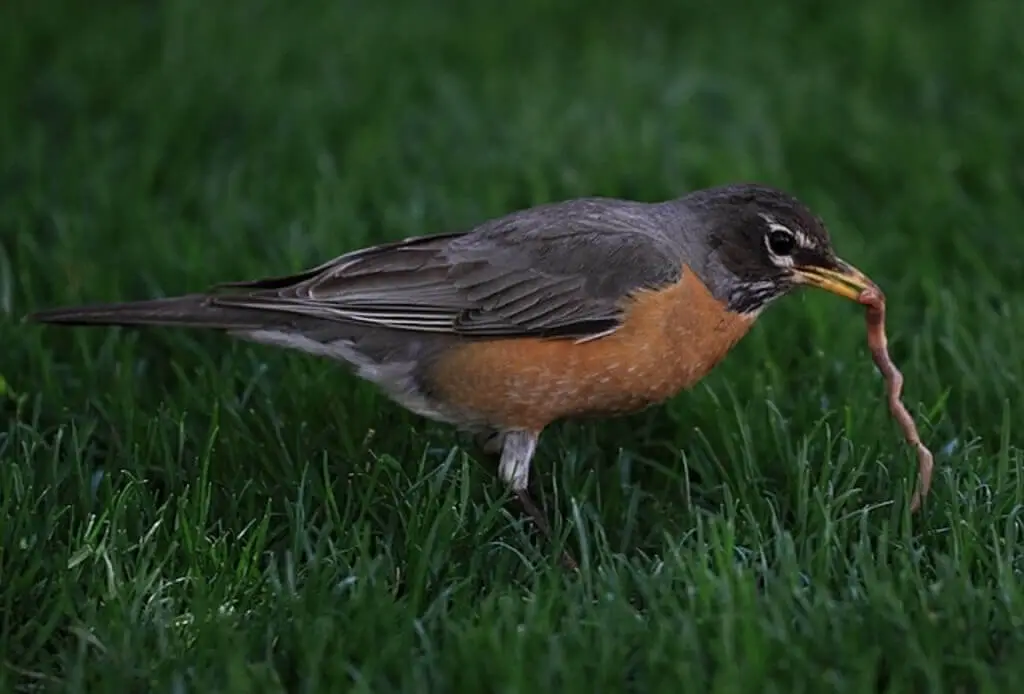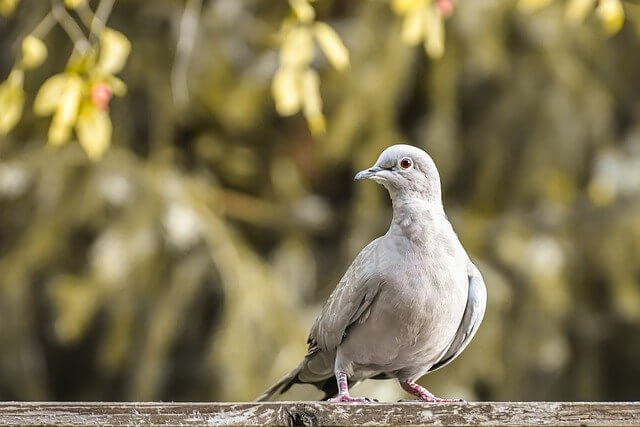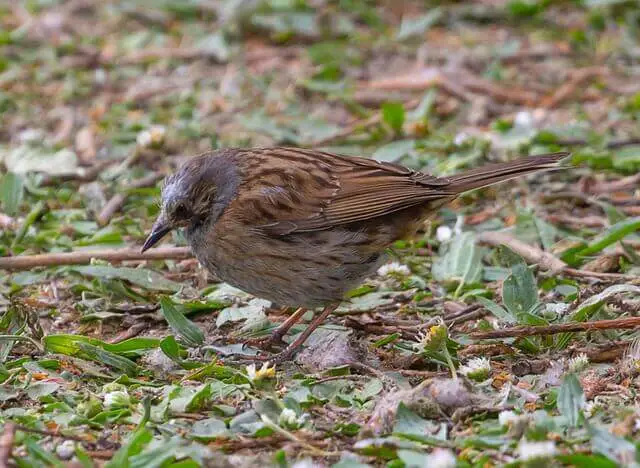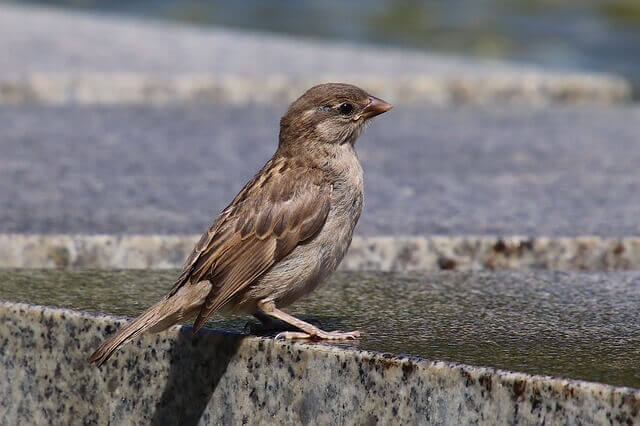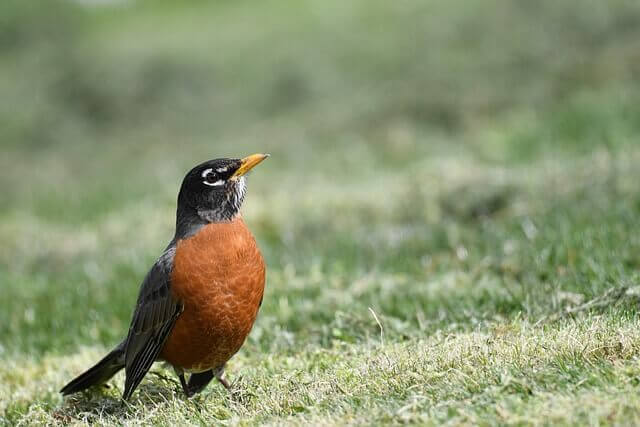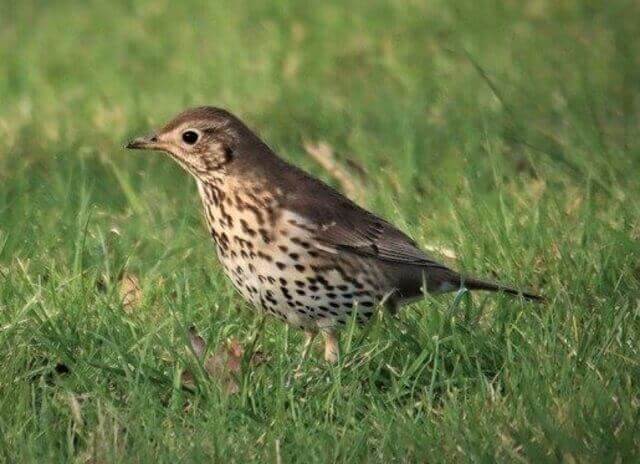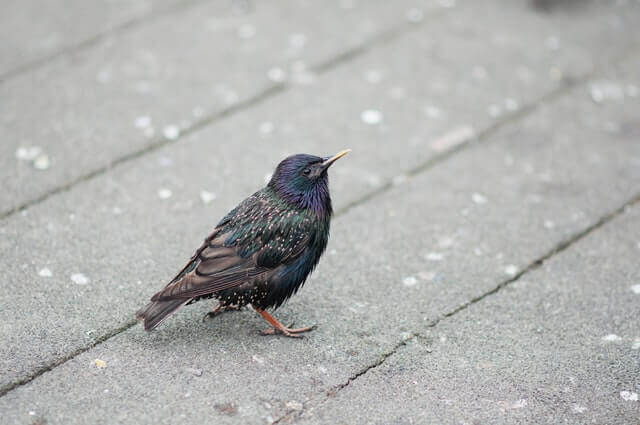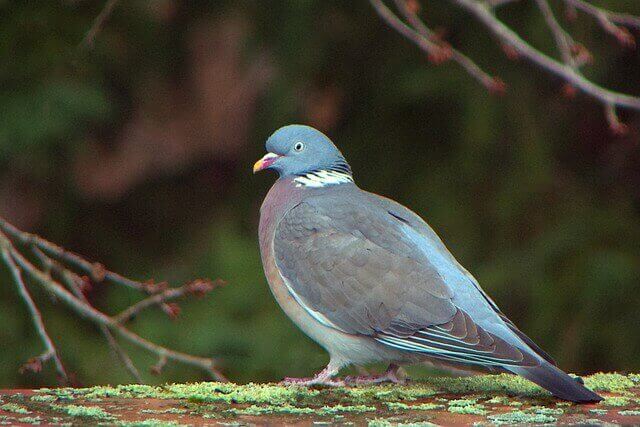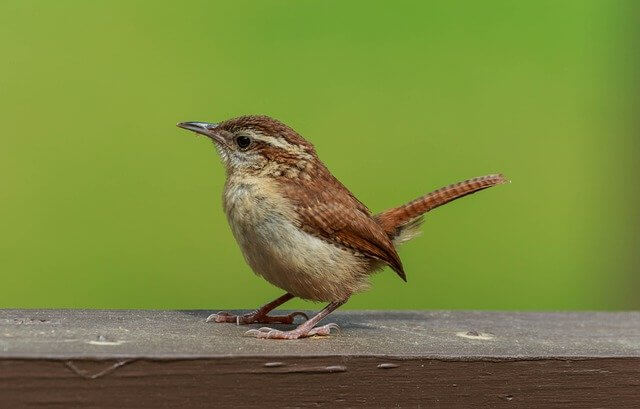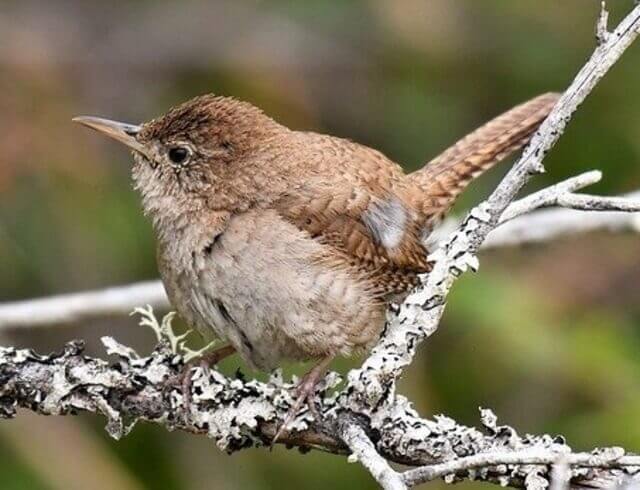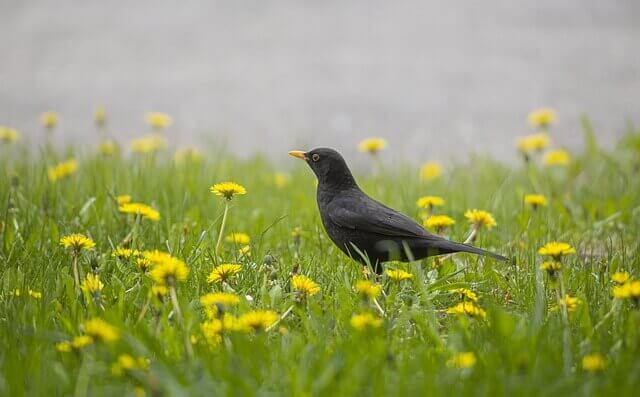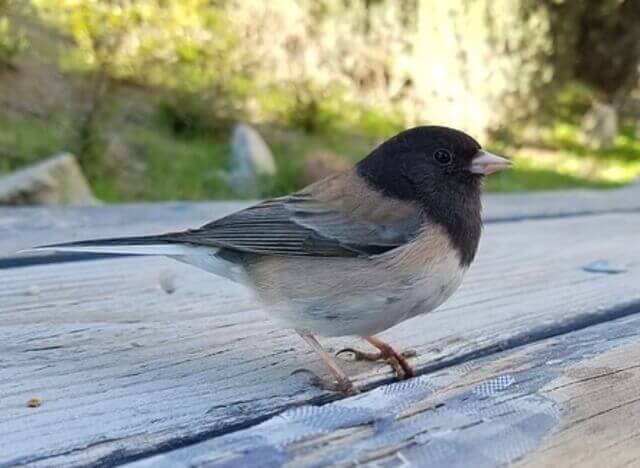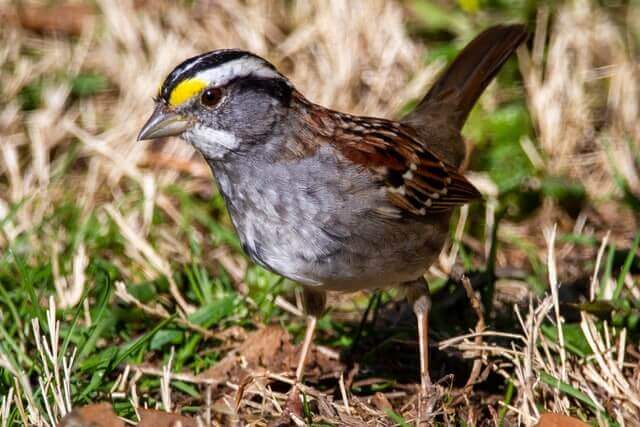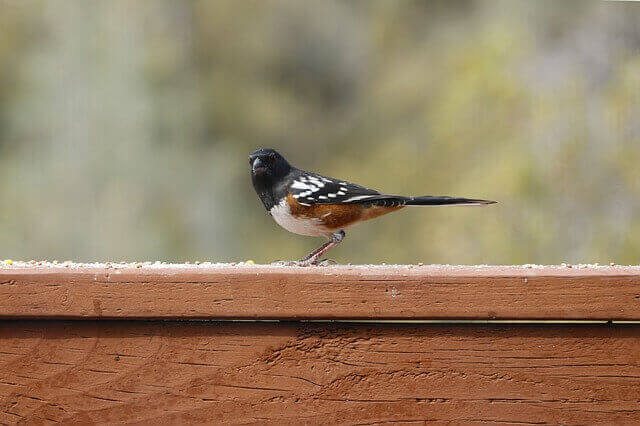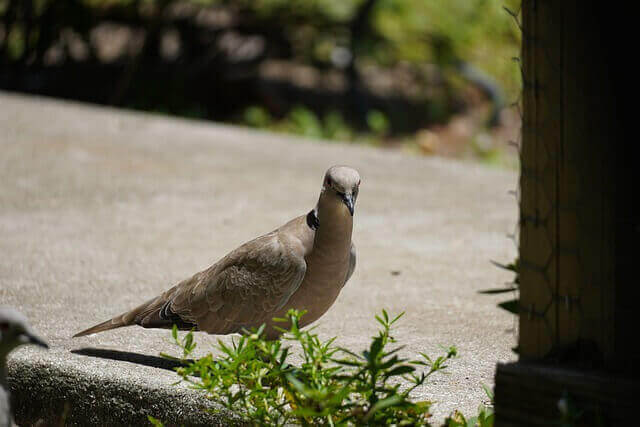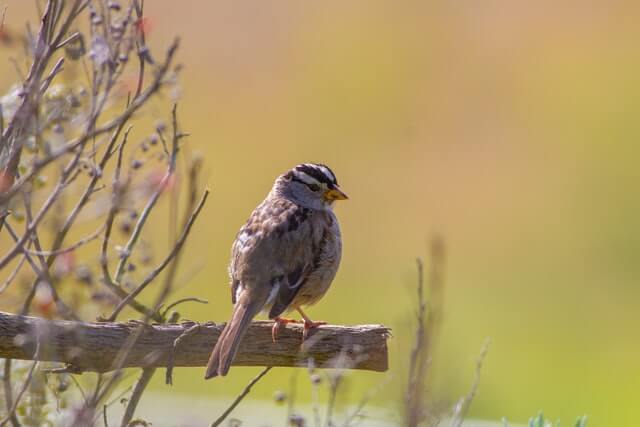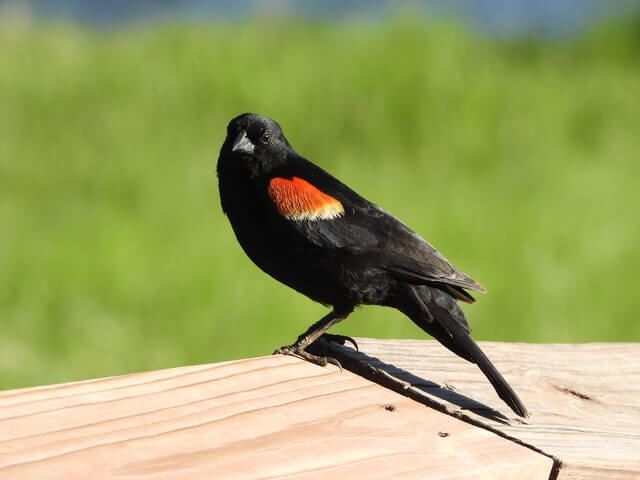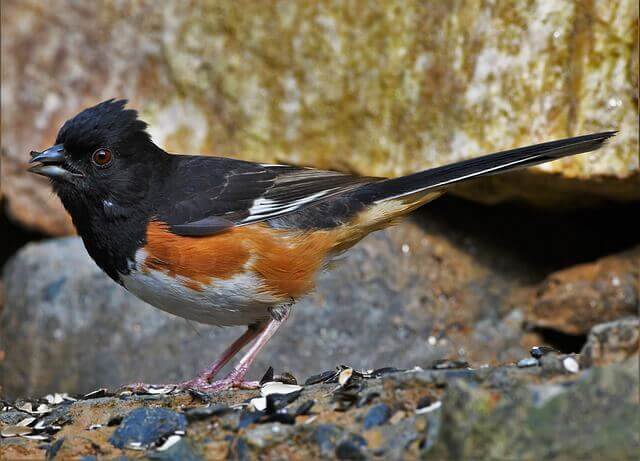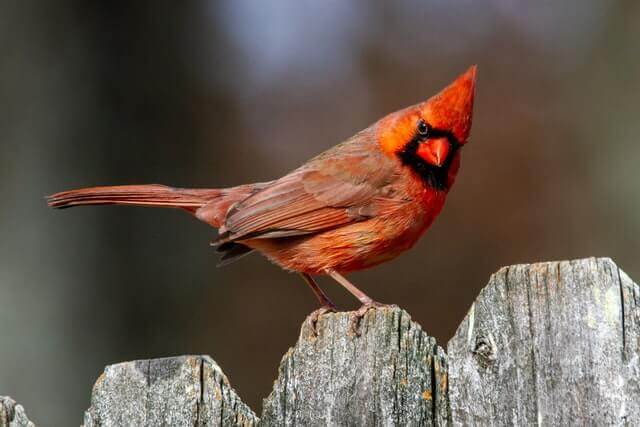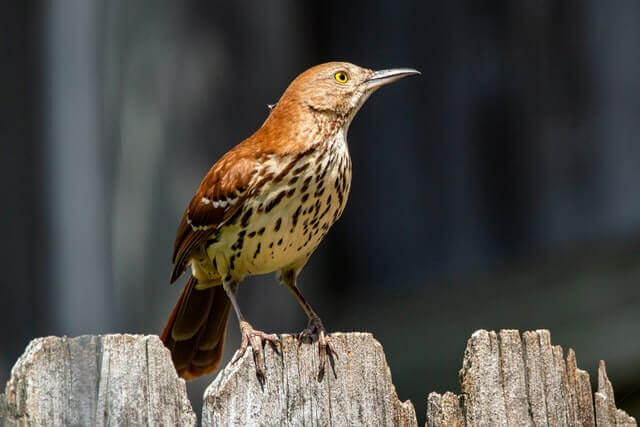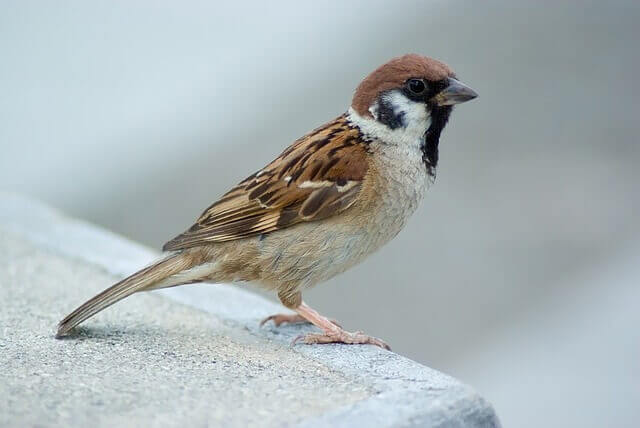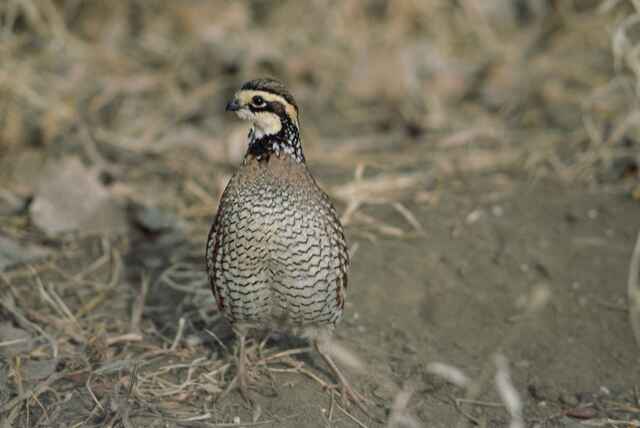Ground-feeding birds are a fascinating and diverse group of avian species. From sparrows to quail, many birds prefer to feed on the ground rather than in trees or on bird feeders.
In this article, we’ll explore 25 birds that feed on the ground, that can be found across North America, providing photos and details about each species for easy identification.
Whether you’re a seasoned birder or just starting out, learning about these unique birds can help you better appreciate the natural world around you.
Table of Contents
- 1 Common Chaffinch
- 2 Eurasian-collared Dove
- 3 Dunnock
- 4 House Sparrow
- 5 Mistle Thrush
- 6 American Robin
- 7 Song Thrush
- 8 European Starling
- 9 Wood Pigeon
- 10 Carolina Wren
- 11 House Wren
- 12 Common Blackbird
- 13 Dark-eyed Junco
- 14 White-throated Sparrow
- 15 Spotted Towhee
- 16 Mourning Dove
- 17 White-crowned Sparrow
- 18 Red-winged Blackbird
- 19 Eastern Towhee
- 20 Northern Cardinal
- 21 Brown Thrasher
- 22 Song Sparrow
- 23 American Tree Sparrow
- 24 California Quail
- 25 Bobwhite Quail
- 26 Types of Ground Feeders: Choosing the Right One for Your Yard
- 27 Foods to Offer Ground-Feeding Birds: Variety is Key
- 28 Tips for Ground Bird Feeders
- 29 Author
Common Chaffinch
The Common Chaffinch is known to feed on the ground in both arid and temperate regions; it has been observed digging through fallen leaves, leaf litter or snow to find food. It’s not unusual to see them feeding along roadsides, where they may also be seen taking dust baths.
- Length: 5.5 – 6.0″ in.
- Weight: 20 – 24 g.
- Wingspan: 10.0 – 11.0″ in.
- Range: Europe, North Africa, and parts of Asia.
- Habitat: Woodland to open country, and urban areas such as parks and gardens.
- Diet: Mainly insects, seeds and berries in the winter.
Eurasian-collared Dove
The Eurasian-collared dove is a bird that’s found in southern and central Texas, including urban areas. They are often seen around livestock and will eat seeds from weeds or grasses when food is scarce. The birds can also be found feeding on insects like beetles, ants, wasps, caterpillars, and butterflies which they pick up off of the ground while walking slowly back and forth across an area to find them.
- Length: 11.4-11.8 in (29-30 cm)
- Weight: 4.9-6.3 oz (140-180 g)
- Wingspan: 13.8 in (35 cm)
- Range: Central America, the Caribbean, North Africa, South Asia to Southeast Asia.
- Habitat: Deserts, grasslands, dry scrubland, wet rainforest, moist savanna and forests.
- Diet: Seeds, fruits, and grains.
Dunnock
Dunnocks are ground feeders. They will search for worms, slugs, and other invertebrates in the leaf litter on the forest floor. Dunnocks have a diet that consists mainly of insects such as ants, beetles, flies, and spiders, which they find by probing under fallen leaves or digging into rotten logs.
- Length: 5.3–5.5″ in. (13.5–14 cm)
- Weight: 0.74 oz. (21 g.)
- Wingspan: 7.9″ in (20 cm)
- Range: Europe, Asia and parts of Africa.
- Habitat: Forest edges to thickets near open woodland or agricultural land.
- Diet: Insects, fruits, berries, seeds and even eggs.
House Sparrow
House sparrows are ground feeders and primarily eat seeds, grains, and other plant matter. They typically forage on the ground, but will also fly up to feed on seed heads. House sparrows can be found in most areas of North America as well as parts of South America, Europe, Asia, Africa, and Australia.
- Length: 5.7-7.1 in (14.5-18 cm)
- Weight: 0.92-1.1 oz (26-31 g)
- Wingspan: 7.9-10.0 in (20-25.5 cm)
- Range: Europe, Asia, Africa, North America and South America.
- Habitat: Open areas such as fields and parks.
- Diet: Insects, seeds, and food scraps.
Mistle Thrush
Mistle thrushes are medium-sized songbirds with distinctive grayish-brown plumage that lives in North America, Europe, and Asia. Mistle Thrush is a type of bird that feeds on the ground. These birds have been known to eat seeds, berries, snails, and other insects found on the ground. Mistle Thrush will even be seen eating small worms and larvae from decomposing leaves.
- Length: 10.5-11.0″ in (26.7-27.9 cm)
- Weight: 91 to 168 g (3.2 to 5.9 oz)
- Wingspan: 17-18″ in (43.2-45 cm)
- Range: Europe, United States and Canada.
- Habitat: Farmland, meadows, orchards, parks and gardens.
- Diet: Mostly insects such as beetles, flies, ants, spiders, moths and caterpillars.
American Robin
American Robins are medium-sized birds that can be found throughout North America. The American Robin is a well-known bird that is often seen hopping around on the ground in search of food. These birds will feed on seeds, berries, worms, and insects which they typically find on the ground.
- Length: 8.3-11.2 in (21-28.5 cm)
- Weight: 2.8-3.0 oz (78-86 g)
- Wingspan: 11.8-15.7 in (30-40 cm)
- Range: North-eastern United States to southern Canada and south to Central America.
- Habitat: Open woodlands, suburbs, parks, agricultural fields and brushy hillsides with scattered trees.
- Diet: Mainly insects, berries and other fruit.
Song Thrush
The song thrush is a type of bird that lives in North America. The song thrush is a ground feeder, which means it forages on the ground to find food. The song thrush eats worms, snails, insects such as grasshoppers and beetles; seeds such as juniper berries; fruit such as cherries or crab apples that have fallen from trees.
- Length: 7.8-9.3″ in (19.8-23.6 cm)
- Weight: 1.8-3.8 oz (52-109 g)
- Wingspan: 12.6-13.4 in (32-34 cm)
- Range: North America, South America, Europe and Asia.
- Habitat: Woodland edges and clearings with bushes for nesting sites.
- Diet: Insects, earthworms, slugs, snails, seeds and berries as well as small birds’ eggs.
European Starling
European starlings are ground-feeding birds, that feed on the ground in groups at dawn and dusk. They will search for insects, and other small invertebrates in the soil, but they also eat fruit that has fallen to the ground from trees above them. They typically nest on the ground and live in grasslands, pastures, parks, cemeteries, and golf courses.
- Length: 8.0-9.0 in (20.3-22.8 cm)
- Weight: 2.1-3.4 oz (59-97 g)
- Wingspan: 12.1-15.9 in (30.7-40.4 cm)
- Range: North America as well as Europe, Africa and Asia.
- Habitat: Urban areas, coastal marshes, farmlands, mountainsides, and forests.
- Diet: Seeds, fruits, insects, small animals like mice or voles, earthworms and snails.
Wood Pigeon
Wood pigeons live all over the world and can be found throughout North America. Wood Pigeons are birds that have adapted to living in urban areas. They eat grain, bread crumbs, and birdseed which they find on the ground of an area. Wood pigeons are also attracted to food placed out for them by humans and can often be seen feeding alongside crows, sparrows, blackbirds, jays, magpies, and grackles.
- Length: 14.6-17.3 in (37–44 cm)
- Weight: 11.0-21.8 oz (300-617 g)
- Wingspan: 29.1-31.1″ in (74-79 cm)
- Range: Mostly found in Europe and Asia and some parts of North Africa.
- Habitat: Forests, agricultural fields, parks, and urban areas.
- Diet: Mainly of berries, seeds, grains and leaves from plants.
Carolina Wren
Carolina Wrens are small songbirds that spend their time on the ground or close to it. These birds feed on insects, fruit, and other small invertebrates. One of the most notable features of Carolina Wrens is how they feed in a manner similar to chickens. The wren uses its long beak to poke around in grasses and under logs for food like ants or grubs.
- Length: 4.3-5.7 in (11-14.5 cm)
- Weight: 0.6-0.8 oz (17-23 g)
- Wingspan: 11.0-11.4 in (28-29 cm)
- Range: Eastern North America, South-eastern United States, Southern Canada, and Mexico.
- Habitat: Brushy areas like forests, thickets, hedges along field edges, shrubs, urban areas.
- Diet: Insects, spiders, berries and other fruit.
House Wren
House Wrens are found in the Americas and on Caribbean islands. They have been known to be ground feeders, so they will eat seeds and insects that live close to the ground or vegetation. In addition, they also eat other small animals such as earthworms, millipedes, slugs, snails, and more. In fact, they feed on the ground much more than other wren species.
- Length: 4.0-5.3 in (10-13.5 cm)
- Weight: 0.3-0.5oz (9.5-13 g)
- Wingspan: 5.3-5.9 in (13.5-15 cm)
- Range: Eastern United States, southern Canada, central Mexico, northern South America, and Cuba.
- Habitat: Meadows, fields, parks and gardens with trees or shrubs for nesting sites and shelter.
- Diet: Insects, spiders, berries and other fruit.
Common Blackbird
Blackbirds are a popular species in the United States. They can be found all over the country, and they don’t seem to mind what kind of habitat they live in. Are blackbirds ground feeders? Yes, in a sense. Blackbirds will often forage on the ground and under shrubs, looking for insects or other food items. However, most of their time is spent perched on trees eating fruit and berries from the branches.
- Length: 7.9-10.2 in (20-26 cm)
- Weight: 2.1-3.1 oz (59-87 g)
- Wingspan: 13.8-14.6 in (35-37 cm)
- Range: North America, Europe, and Asia.
- Habitat: Parks, on buildings, gardens, or even near farms.
- Diet: Insects, seeds, berries, fruit and worms.
Dark-eyed Junco
The Dark-eyed Junco is a ground feeder, and its diet consists of insects, seeds, and berries. They are found in open woodlands and scrubby areas near water sources such as streams or lakes. Juncos breed throughout the United States during springtime, often building nests under shrubs or in grassy areas near low bushes.
- Length: 5.3-6.5 in (13.5-16.5 cm)
- Weight: 0.6-1.1 oz (17.5-31 g)
- Wingspan: 6.7-10.2 in (17-26 cm)
- Range: Common and found throughout most of North America except parts of central Canada and Alaska.
- Habitat: Forests, meadows, and other open habitats with brushy undergrowth.
- Diet: Insects, spiders, berries, seeds and nuts.
White-throated Sparrow
The White-throated Sparrow is a small songbird that can be found throughout North America. They are very active birds and will feed on the ground as well as in trees. In general, White-throated sparrows have an omnivorous diet consisting of seeds, insects, eggs, and other small animals. When they are feeding on the ground, they use their bill to flip leaves overlooking for food underneath.
- Length: 6.0-7.5 in (15-19 cm)
- Weight: 0.7-1.2 oz (21-33 g)
- Wingspan: 7.9-9.3 in (20-23.5 cm)
- Range: Eastern United States to Canada.
- Habitat: Open woodlands, fields, and suburban yards.
- Diet: Mostly insects but also seeds and berries when available.
Spotted Towhee
Spotted Towhees are small birds that often spend their time foraging on the ground. They have a variety of techniques to help them find food, including pecking at plants, digging with their bills, flipping leaves over, and looking underneath. Spotted Towhees are very adept foragers, which is why they spend so much time searching on the ground. They will eat everything from seeds to bugs but also enjoy invertebrates like snails and slugs.
- Length: 6.5-8.7 in (16.5-22 cm)
- Weight: 1.1-1.7 oz (32-49.5g)
- Wingspan: 10.6-11.2 in (27-28.5 cm)
- Range: Eastern Canada to the western U.S., Mexico, and Central America.
- Habitat: Shrubs or brushy areas along forest edges or clearings near streams.
- Diet: Seeds, berries, invertebrates (insects), small reptiles, amphibians, and eggs of other birds.
Mourning Dove
Mourning doves are one of the most common birds in North America. They feed mostly on seeds, grains, and nuts found on the ground. The mourning dove’s diet is also supplemented by eating worms and insects that they find in the soil near where they’re feeding. Mourning doves can be seen all over your backyard garden or any place with large amounts of plants growing close to the ground for them to eat from, as well as a constant supply of fresh water nearby.
- Length: 8.3-13.8 in (21-35 cm)
- Weight: 3.3-6.0 oz (94-170 g)
- Wingspan: 16.1-17.7 in (41-45 cm)
- Range: North America, South America, Central America, and the Caribbean.
- Habitat: Forest edges, fields near woodlands, pastures near open areas.
- Diet: Insects, seeds, grains, fruits and berries
White-crowned Sparrow
The White-crowned Sparrow is a small bird that can be found in North America. They are migratory birds and usually travel from the north to the south, and vice versa. One of their main habitats is on top of or near trees; they can also be seen feeding on seeds on the ground or foraging for food.
- Length: 5.5-6.3 in (14-16.5 cm)
- Weight: 0.9-1.0 oz (24-28 g)
- Wingspan: 7.9-9.4 in (20-24 cm)
- Range: United States and Canada, except for some parts of the western states.
- Habitat: Meadows, grasslands, forest edges, brushy areas near water, willow thickets, farm fields.
- Diet: Consists mostly of seeds, but they also eat berries, grains, nuts, insects and even small lizards.
Red-winged Blackbird
The Red-winged Blackbird is a species of bird that prefers to feed on the ground. The blackbird is usually found wandering around fields, lawns and sidewalks looking for its next meal. They typically like sunflower seeds or insects as their food source but can also eat worms or crickets if they need too.
- Length: 6.3-9.4 in (16-24 cm)
- Weight: 1.2-2.8 oz (33-78 g)
- Wingspan: 11.8-15.7 in (30-40 cm)
- Range: Southern United States, eastern Canada, and the Western US.
- Habitat: Woodlands and wetlands.
- Diet: Insects and fruit, with some seeds being eaten as well.
Eastern Towhee
Eastern Towhees, are native to the eastern United States and southern Canada. They are one of many species that rely on food sources from plants and insects for survival. The Eastern Towhee prefers eating ants, beetles, and spiders, which it finds on the ground, by pecking at loose soil with its bill. The Eastern Towhee is not picky about what type of ant or beetle it eats; they will eat any small insect that comes their way.
- Length: 6.7-8.3 in (17-21 cm)
- Weight: 1.1-1.9 oz (31-53 g)
- Wingspan: 7.9-11.2 in (20-28.5 cm)
- Range: Eastern United States, Northeastern United States, and Southwestern Canada.
- Habitat: Fields, forest edges, open woodlands, and near streams.
- Diet: Mostly insects, seeds from weed plants, berries and small animals.
Northern Cardinal
Northern Cardinals are ground feeding birds that live in North America. They have a friendly personality and can be found in gardens, parks, forests, meadows and wetlands. The Northern Cardinal is not migratory and will stay in the same area year round. Their diet consists of seeds from weeds or grasses as well as insects such as spiders, crickets and caterpillars. If you see one foraging on the ground, it means they’re hungry because their food sources are low or scarce.
- Length: 7.9-9.1 in (20-23 cm)
- Weight: 1.45-1.7 oz (41-48 g)
- Wingspan: 9.8-12.4 in (25-31.5 cm)
- Range: Eastern United States, Canada and Mexico.
- Habitat: Deciduous forests, coniferous forests, mixed woodlands, prairies, chaparral areas (shrubs), savannas (grassland with scattered trees), semi-deserts or deserts with scrubby vegetation and shrubs, and even sagebrush plains.
- Diet: Seeds, fruits, berries, insects and other small animals.
Brown Thrasher
The Brown Thrasher is a type of bird that loves to feed on the ground. The Thrashers can be found in North America, and are mostly seen on the coastlines and other moist habitats. They eat insects, worms, spiders, centipedes, millipedes, snails as well as small reptiles such as lizards and snakes. A lot of times they will feed from the ground by flipping leaves over with their feet to find food hiding underneath them.
- Length: 8.8-11.8 in (22.5-30 cm)
- Weight: 2.1-3.1 oz (60-89 g)
- Wingspan: 11.4-12.8 in (29-32.5 cm)
- Range: North America, Central America, South America, and parts of Europe.
- Habitat: Deciduous forests, suburban areas.
- Diet: Insects, seeds, berries and fruit.
Song Sparrow
Song sparrows are ground foraging birds that live in a variety of habitats including woodlands, grasslands, marshes and brushy areas. They nest on the ground under shrubs or other cover close to the water’s edge. The song sparrow is an opportunistic feeder, which means it will eat what is available to them in their habitat. Insects such as beetles, ants and flies make up about one-third of its diet, while fruits make up about 12%.
- Length: 4.5-6.9 in (11.5-17.5 cm)
- Weight: 0.4-1.9 oz (11-54 g)
- Wingspan: 6.7-9.4 in (17-24 cm)
- Range: Most of the United States and Canada except for Florida and parts of the Rocky Mountains.
- Habitat: Grasslands, wetlands, orchards, parks and gardens.
- Diet: Small invertebrates, seeds, and berries.
American Tree Sparrow
American Tree Sparrows are ground foraging birds. They use their short, round bills to search the forest floor for seeds and insects. They eat many types of seeds from trees such as maples, oaks, and beech trees. Additionally they will eat grasses, weed seeds, and berries that have fallen on the ground or have been eaten by other animals before them.
- Length: 5.1-5.5 in (13-14 cm)
- Weight: 0.47-1.0 oz (13-29 g)
- Wingspan: 9.1-9.4 in (23-24 cm)
- Range: North America south to Mexico.
- Habitat: Open fields, farmland, and meadows.
- Diet: Insects and seeds from grasses, herbs, shrubs, trees or vines, berries.
California Quail
The California Quail is a ground feeding bird, and it prefers to eat seeds, berries, and insects. This quail has adapted to live in open areas with little or no vegetation on the surface. This habitat may be arid or semi-arid grasslands; rocky hillsides; deserts; or brushy fields with scattered trees. They have also adapted to urban areas, where they eat food from residential lawns and other people’s yards. They also may feed on grains or seed from human consumption left behind after picnics or sporting events.
- Length: 9.4-11.0 in (24-28 cm)
- Weight: 5.0-8.2 oz (141-232 g)
- Wingspan: 12.2-15.0 in (31-38 cm)
- Range: North America from central Canada to northern Mexico.
- Habitat: Near water sources, as well as shrubland or grasslands.
- Diet: Mainly of seeds, insects, fruit and berries.
Bobwhite Quail
Bobwhite Quail are ground feeding birds that can be found in North America, where they live in parts of Texas, Louisiana, Oklahoma, Arkansas and Mississippi. These small animals live in family groups of 4-6 and are often seen in open fields or grasslands. There are many types of food they can eat including grass, insects, worms and seeds. These quails usually stay in the same area throughout their life which is why they don’t migrate like other birds do.
- Length: 9.1-11.4 in (23-29 cm)
- Weight: 6.0 to 6.1 oz (170-174 g)
- Wingspan: 12.6-15.2 in (32-38.5 cm)
- Range: North America and in the Southern regions of Europe.
- Habitat: Prairies, grasslands, open woodlands, scrubby fields, thickets and brushy forests.
- Diet: Grasses, grains, seeds, berries and invertebrates such as worms and insects.
Types of Ground Feeders: Choosing the Right One for Your Yard
Ground feeders are a great way to attract a variety of bird species to your backyard. There are several types of ground feeders to choose from, depending on your needs and preferences. Here are some of the most common types:
- Tray Feeders: Tray feeders are simply flat trays that can be placed directly on the ground. They are easy to use and can accommodate a large number of birds. Some tray feeders come with a cover or roof to keep the seed dry and sheltered.
- Platform Feeders: Platform feeders are similar to tray feeders but are raised off the ground on legs. They can be made of wood, metal, or plastic and can be customized to fit your backyard’s aesthetic.
- Hopper Feeders: Hopper feeders are elevated boxes with a sloping roof that can be modified for ground feeding. Choose a model designed for ground feeding or remove the hanging mechanism from a hanging hopper feeder. Use a high-quality seed mix and regularly clean the feeder to attract a variety of bird species to your backyard.
- Pet Food Dishes or Other Simple, Shallow Containers: Simple containers such as pet food dishes or pie tins can be used as ground feeders. They are easy to use and can be filled with a variety of foods for birds.
- Ground-Level Bird Baths: Ground-level bird baths can double as a feeding area for ground-feeding birds. They can be made of concrete, stone, or other materials and can be filled with water or seed.
When choosing a ground feeder, consider the type of birds you want to attract, the size of your backyard, and your budget. Providing a dedicated feeding area for ground-feeding birds will not only bring you hours of bird-watching enjoyment but will also help support the local bird population.
Foods to Offer Ground-Feeding Birds: Variety is Key
Ground-feeding birds have a diverse diet, and offering a variety of foods can attract a greater variety of bird species to your backyard. Here are some foods to consider when creating a feeding area for ground-feeding birds:
- Seeds: Offer a variety of seeds such as sunflower, millet, and safflower seeds. These are popular among many bird species and are readily available at most pet stores and bird supply shops.
- Grains: Ground-feeding birds also enjoy grains such as cracked corn, oats, and wheat. These can be purchased in bulk at feed stores and are a cost-effective option for feeding birds.
- Fruits: Offer fresh or dried fruits such as raisins, apples, and berries. These provide a natural source of sugar and nutrients for birds.
- Nuts: Ground-feeding birds love nuts such as peanuts, almonds, and walnuts. These are a good source of protein and healthy fats for birds.
- Insects: Offer live or dried mealworms, crickets, and other insects. These are a natural food source for many bird species and are especially important during breeding season.
Remember, variety is key when offering food to ground-feeding birds. Try to offer a mix of seeds, grains, fruits, nuts, and insects to attract a greater variety of bird species to your backyard. Providing a dedicated feeding area for ground-feeding birds will not only bring you hours of bird-watching enjoyment but will also help support the local bird population.
Tips for Ground Bird Feeders
Tips for Ground Bird Feeders: Maximizing Your Backyard Bird-Watching Experience
Ground bird feeders can provide hours of entertainment for backyard bird-watchers. Here are some tips to help you get the most out of your ground bird feeder:
- Choose the Right Location: Place your ground feeder in a location that is easily visible from your house or outdoor seating area. This will allow you to watch birds while they feed.
- Keep it Clean: Regularly clean your ground feeder to prevent mold and bacteria buildup. Use a mild soap and water solution to clean the feeder, and rinse it thoroughly before refilling it with seed.
- Offer a Variety of Foods: Offer a variety of foods such as seeds, grains, fruits, nuts, and insects to attract a greater variety of bird species to your backyard.
- Provide Shelter: Ground-feeding birds are vulnerable to predators such as cats and hawks. Provide shelter such as bushes or trees near your ground feeder to give birds a place to hide.
- Use a Squirrel Baffle: Squirrels can be a nuisance around bird feeders. Use a squirrel baffle to prevent them from climbing up the feeder and stealing the seed.
- Keep it Stocked: Regularly refill your ground feeder with seed to keep birds coming back to your backyard.
By following these tips, you can maximize your backyard bird-watching experience and create a safe and welcoming environment for ground-feeding birds. Enjoy the beauty of nature right from your own backyard!

